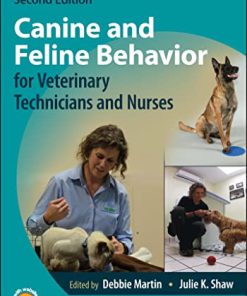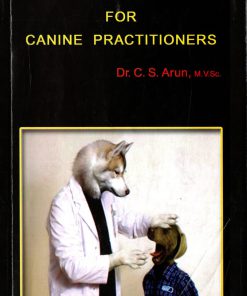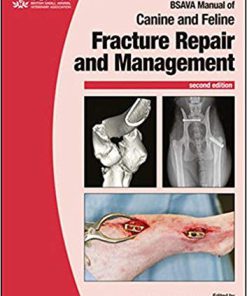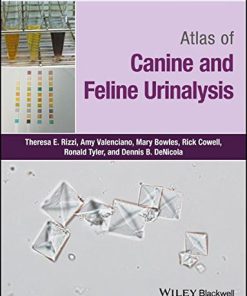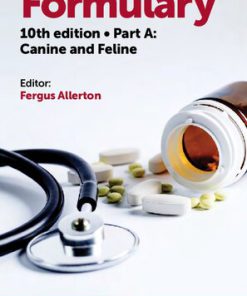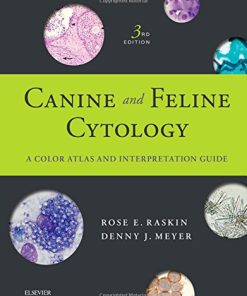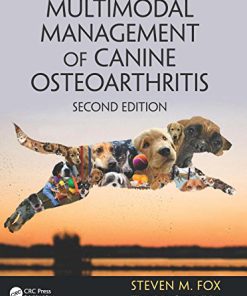Canine and feline geriatric oncology honoring the human animal bond 2nd Edition by Laurie Kaplan,Alice Villalobos 9781119290445 1119290449
$50.00 Original price was: $50.00.$25.00Current price is: $25.00.
Canine and feline geriatric oncology honoring the human animal bond 2nd Edition by Laurie Kaplan,Alice Villalobos- Ebook PDF Instant Download/Delivery:9781119290445,1119290449
Full download Canine and feline geriatric oncology honoring the human animal bond 2nd Edition after payment

Product details:
ISBN 10:1119290449
ISBN 13:9781119290445
Author:Laurie Kaplan,Alice Villalobos
Canine and Feline Geriatric Oncology: Honoring the Human-Animal Bond, Second Edition provides a complete clinical approach to the most common neoplasias in geriatric dogs and cats.
- Provides the tools needed to diagnose and treat aging pets with cancer and to help clients make the best decisions for themselves and their animals
- Addresses the “what-ifs” that often arise during interactions with clients of aging pets with cancer and helps to determine when a pet should enter the hospice phase
- Features many vignettes and real-life case studies to demonstrate the issues faced by clinicians and owners dealing with older dogs and cats with cancer and end-of-life issues
- Fully updated and expanded with new and revised information, including new knowledge on palliative and hospice care and self-care techniques for carers
Canine and feline geriatric oncology honoring the human animal bond 2nd Table of contents:
Part One
Chapter 1: Molecular Biology of Cancer and Aging
What Is Cancer? How Does It Start?
Tumor Suppressor Genes, Apoptosis, and Genomics
Cancer and Aging
One Medicine and Cancer Awareness
Epigenetics, Environmental Influences, Toxins, and Risk Factors
Immuno-Oncology or Onco-Immunology
Retroviral and Infectious Disease in Cancer
Endocrine Influences in Tumorigenesis
Feline Injection Site Sarcoma (FISS)
How Cancer Kills
Mechanisms of Metastasis
Angiogenesis
Why Are There So Many Kinds of Cancer?
Diagnostic Molecular Technology
What Are Sarcomas, Carcinomas, and Adenocarcinomas?
Blood Cancer
Carcinomas and Adenocarcinomas in Dogs and Cats
What Can Be Done to Halt Cancer in Pets?
Much Is Left Unsaid and Unaddressed
Ageism
Physiologic and Chronologic Aging Variability
Incidence
Preventable Tumors in Geriatric Pets
Summary
References
Suggested Reading
Chapter 2: Caring for Geriatric Cancer Patients: The Concept of Pawspice and What Is Needed Aside from Medical Care
Age Brings More Complexity and Susceptibility
The Bond Grows Stronger with Age
Individualize Client Character
Sensitivity Self-Assessment
Defining the Human–Animal Bond
Conversing with Clients
Dealing with Inappropriate Depression and Grief
Dealing with Anticipatory Grief
Disenfranchised Grief
Inappropriate Optimism: Keep Reality Buttons in Place
Expect Shock and Dread
Consider Extenuating Circumstances
Pawspice Care Philosophy
Summary
References
Suggested Reading
Part Two
Chapter 3: The Warning Signs of Cancer in Geriatric Pets
Principles and Practice in Geriatric Oncology
Warning Signs of Cancer in Dogs and Cats
Commonly Overlooked Prodromal Warning Signs of Cancer
Oral Cancers are Discovered Late
Warning Signs of Skin Cancer in Cats
Cutaneous Lymphoma: Often Misdiagnosed as Dermatitis
Mast Cell Tumors (MCT)
Rapidly Growing Masses in the Skin
Warning Signs of Mammary Cancer in Dogs
Breast Tumors in Cats: Malignant Mammary Carcinoma
Cancer of the Nasal Passages
Warning Signs of Abdominal Masses
Warning Signs of GI Lymphoma in Cats
Warning Signs of Hepatic Tumors
Warning Signs of Splenic Tumors
Chronic Hematuria Heralds Bladder or Prostate Cancer
Warning Signs of Colon Tumors
Warning Signs of Anal Sac Carcinoma
Dealing with Geriatric Caregivers with Geriatric Pets
Acute Warning Signs
Collapse or Seizures: May Be a Ruptured Abdominal Mass or Brain Tumor
Dyspnea: May Indicate Thoracic Masses or Effusions
Pathological Fracture: May Be Osteosarcoma
Acute Pain or Paresis: May Be from Spinal Cord Tumors
Behavior Changes: May Be from Brain Tumors
Paraneoplastic Syndromes
Anorexia and Hepatic Lipidosis
Thoughts on Feline Anorexia
Cats with Oral Cancer Require Feeding Tubes
Sarcopenia versus Cancer Cachexia, an Insidious PNS
How Cancer Causes Anemia
Hypercalcemia of Malignancy (HM)
Warning Signs of Hypercalcemia of Malignancy (HM)
Workup and Treatment of Hypercalcemia of Malignancy (HM)
Pain Is a Warning Sign and a Paraneoplastic Syndrome
Client Education
References
Suggested Reading
Chapter 4: Basic Types of Cancer and Their Biological Behavior
Introduction
Carcinomas
Sarcomas
Blood (Hematopoietic) Cancer
CNS Tumors
Miscellaneous Tumors and Tumors of Unknown Origin
Approaching Cancer According to Location
Summary
References
Suggested Reading
Chapter 5: Generating the Diagnosis and Prognosis of Cancer in Geriatric Pets
Principles and Perspective for Diagnosis in Geriatric Cancer Patients
Diagnostic Tools and Techniques Used for Diagnosis and Staging Cancer
Fine Needle Aspiration Cytology: A Very Handy but Underutilized Tool
Large Aspiration Needle Chop for Firm Tumors
Characteristics of Cancer in Cytology
Punch and Tru-cut Core Biopsy Needle Techniques
Incisional versus Excisional Surgical Biopsy for Diagnosis
Histopathology Terms: Adequate versus Complete Margins
Intraoperative Cytology
A Word About Unhelpful Diagnostic Abdominal Surgery
Point-of-Service Panels and Cytology of Fresh Blood Smears
Clinical Pathology and the Geriatric Cancer Patient
Imaging Detectable Tumors
Imaging Tumors with Radiography
Imaging Tumors with Ultrasound
Screening Senior and Geriatric Patients with Imaging
Imaging Tumors with CT, MRI, and PET
Positron Emission Tomography
Hybrid Imaging Technology
Nuclear Imaging with Radioisotopes
Bone Scans and Function Scans
Screening Strategy for Active Surveillance
Staging Cancer
Canine Lymphoma Staging System
Phenotyping Lymphoma and Leukemia for Prognosis and Treatment
Tumor Markers for Diagnosis of Cancer and Targeted Therapy
Gene Microarray Results Can Guide Therapeutic Options
Complimentary or Alternative Methods Used in the Diagnosis of Cancer
Summary
References
Part Three
Chapter 6: Treating Cancer in Geriatric Pets
Principles and Philosophic Perspective for Treating Geriatric Cancer Patients
Overview of the Four Musketeers of Cancer Therapy
Unhelpful Surgery
Neoadjuvant and Perioperative Therapy
Novel Approaches
Multimodality, Combinatorial Therapy
What is Integrative Therapy?
The Role of Surgery in Cancer Management and “When Is It Too Much Surgery”
Special Considerations for Surgery
A General Rule of Thumb for Oncologic Surgery
A Letter to Every Surgeon (Please Read Before Recommending Surgery)
Reconstructive Surgery
Summary: The Role of Surgery in Cancer Management
Chemotherapy in the Management of Geriatric Cancer
Handling Chemotherapy Drugs Safely
Classification of Chemotherapy Drugs
Terminology for Applied Chemotherapy
Combination Chemotherapy in Geriatric Pets
Neoadjuvant Chemotherapy
Directed Chemotherapy
Intralesional Chemotherapy
Locoregional Tumor Treatments with Interventional Radiology
Chemotherapy with Rapamycin May Provide Antiaging Benefits
Protocols for Various Tumor Types
Precautions with Specific Chemotherapy Agents
The Treatment Calendar
Summary: Chemotherapy in the Management of Geriatric Cancer
Adverse Effects of Cancer Therapy in Geriatric Pets
Adverse Events Related to Chemotherapy
Treatment for Chemotherapy Toxicity
Summary: Adverse Events of Cancer Therapy in Geriatric Pets
The Role of Radiation Therapy in Cancer Management
Uses of Radiation Therapy
Adverse Events Related to Radiation Therapy
Treatment of Radiation Adverse Events
Multimodality–Multidisciplinary–Combinatorial Therapy
Cancer Drug Resistance and Genomics
Immunotherapy, Cancer Vaccines, and Gene Therapy
Vaccines for Cancer Therapy and Gene Therapy
Suicide Genes
Antiangiogenic Gene Therapy
Clinical Trials in Gene Therapy
Monoclonal Antibodies
Checkpoint Inhibitors, Programed Cell Death Ligands, and Adverse Events
Summary: Immunotherapy, Cancer Vaccines, and Gene Therapy
Antiangiogenesis Therapy with Metronomic Chemotherapy
Chemoprevention and Immunonutrition for Cancer Patients
Confusion and Controversy about Chemoprevention and Immunonutrition
Pets at Risk
Immunonutrition Suggestions
Nutritional Support for Older Cancer Patients
Can Diet Affect Geriatric Cancer Patients?
Summary: Chemoprevention and Immunonutrition for Cancer Patients
Integrative and Alternative Medicine
Accept Clients as Partners in Integrative Decision Making
Herb–Drug Interactions
Summary: Integrative and Alternative Medicine
Electrochemotherapy (ECT)/Electroporation (EP)
Basic Principles
Mechanism of Action
Electrochemotherapy Technique
Equipment, Devices, and Machines
Electrochemotherapy Protocol
Advantages
ECT/EP Approach
Indications
Limitations
Metronomic Chemotherapy in Dogs
Key Points
Introduction
Conventional Chemotherapy versus Metronomic Chemotherapy
Metronomic Chemotherapy
Inflammation and Cancer
NSAIDs in Cancer Treatment
Commonly Used Protocols
Side effects
Clinical Case
Conclusions
References
Suggested Reading
Radiation Oncology
Medical and Surgical Oncology
Herb–Drug Interactions
Electrochemotherapy (ECT)/Electroporation (EP)
Metronomic Chemotherapy in Dogs
Chapter 7: Pain Control for the Geriatric Cancer Patient
Treating Pain Is Good Medicine
Pain Pathways
Cancer-Induced Pain
Nervousness Plus Anxiety Equals Emotional Pain: Go Fear Free!
Short-Acting Immobilization for Chemotherapy
Confronting the Brutality of Pain
Pain Scales and Scoring Charts
Agonist Opioids
NSAIDs for Cancer Pain
Steroids
Psychoactive Pharmaceuticals in Multimodal Therapy for Quality of Life
Integrate Complementary and Alternative Therapy
Fear Free Patient Visits
Multimodality Pain Management
Cats and NSAIDs
Pre-emptive Analgesia for Surgery and Painful Procedures
Using Local Analgesics
Epidurals and Local Pain Control
Perioperative Pain Control
Compounding Pharmacies
Pain Control for Pawspice Care
Adverse Drug Reactions and Interactions in Pain Control
Summary
Cannabis Commentary
References
Suggested Reading
Cannabis Resources
Chapter 8: Decision Making with Advanced and Recurrent Cancer in the Geriatric Patient
Linking Gene Expression to Decision Making for Personalized Cancer Care
The Need for Family Practice Skills
Ethics, Economics, and Empathy Issues
An Inherent Conflict of Interest
How Far Is Too Far?
Patriarchal Practitioners
Framework for Decision Making
Recurrence Bodes an Upset Lifestyle
Aesculapian Authority
Rethinking Advanced Stage Cancer, Recurrence, and Age
Dilemmas During Decision Making
The Veterinarian’s Role in Decision Making
Expect Recurrence and Look for It
Physical Performance Assessment
Frailty, Sarcopenia, Aging, and Cachexia
Dealing with Anemia and Chronic DIC
Other Geriatric Syndromes
Diagnosing Recurrent Cancer
Using Technology for Monitoring Recurrent Cancer
Advanced Stage and Relapsing Lymphoma
Resistant Lymphoma
A Few Words on MOPP Rescue
LoLuC-P: A Low-Cost Protocol for Lymphoma Maintenance
Options Beyond Chemotherapy for Cancer Recurrence
Metronomic Chemotherapy
Recurrent Soft Tissue Sarcoma (STS)
Recurrent Mast Cell Tumors
Options for Clients Who Decline Multiple Surgeries for Recurrent Cancers
Recurrent Hemangiosarcoma
Recurrent, Metastatic Osteosarcoma
Pulmonary Metastatectomy
Recurrent OSA Lesions in the Axial Skeleton
Advanced and Recurrent Mammary Cancer in Dogs
Advanced Stage or Recurrent Mammary Cancer in Cats
Anal Sac Carcinomas, Recurrence, and Metastasis
Residual or Recurrent Nasal Cancer
Multiple Primary Malignancies
The Role of Integrative Medicine in Advanced Stage and Recurrent Cancer
Nutrigenomics, Immunonutrition, and Chemoprevention
Summary
References
Suggested Reading
Chapter 9: When and How to Decide That a Geriatric Cancer Patient Is Terminal
Clarification of Terminology for Terminal
Criteria for Terminal Decision Making
Initial Presentation of a Terminal Case
Hemoabdomen
Osteosarcoma
Advising Deeply Bonded Clients in the End Phase
Attend to the Carer’s Needs
When Do You Use the Word “Terminal”?
The Tumor Is Inoperable, or Is It? Can Stereotactic Radiosurgery Help?
The Long Problem List and Polypharmacy
Healer or Executioner
Chemotherapy for Advanced Stage Geriatric Patients
Palliative Radiation Therapy and SRS for Terminal Patients
Electroporation/Electrochemotherapy for Selected Terminal Patients
Client Consent Forms
The Future is Bright
Summary
References
Chapter 10: Palliative Care: End of Life “Pawspice” Care
What is Aggressive Palliation for Cancer?
Informed Consent and Informed Refusal
Aggressive Palliation and High-Risk Procedures
Pawspice Care for Geriatric Cancer Patients
Reevaluation of Attachment
Home Care 101 for the Pawspice Patient
Pet Aversion to the Caregiver
Willingness: The Essential Ingredient on Both Sides of the Exam Table
The Evolution of Pawspice Philosophy
Education of Home Carers
Assessing Quality of Life Using the “HHHHHMM” (H5M2) QoL Scale
Understanding the HHHHHMM Quality of Life Scale
Help Clients Use the QoL Scale
Satisfaction: An Important Ingredient of Pawspice Care
Pawspice Programs Are Metastasizing
Practical Ideas for Treating Some Specific Disease Conditions
Severe Refractive Vomiting
Severe Pain
Managing Soft and Loose Stools
Immunonutrition and Chemoprevention as Palliative Care
Provide Emotional Support for Carers of Pawspice Pets
Tips for Pawspice/Hospice Patients in Decline
Summary
References
Suggested Reading
Chapter 11: Euthanasia for the Geriatric Cancer Patient
A Philosophy and Principles
Emergency-Related Euthanasia
Cecilia’s Case (Self-Doubt Follows Even Good Decisions)
Planning for Death
Euthanasia Always a Two-Step Process at the Hospital
Do Not Betray the Human–Animal Bond Before Euthanasia!
Suggest a Wake
Compassion and After-Life Services
Dealing with the Pet’s Body for High-Need Clients
Home Euthanasia and Hospice: A Movement in Response to a Need
Compassion Fatigue and Ethics Fatigue
Compassion versus Cure without Care
Posteuthanasia Follow-Up
Sending an After-Life Gift
Sir Walter Scott on the Human–Animal Bond
References
Suggested Reading
Chapter 12: The Veterinary Professional/Client Relationship: Supporting Your Clients – Supporting Yourselves
Background of the End of Life Care/Pet Loss Study
Supporting Your Clients Through the End of Life Care Experience
Information
Resources
Choices
Support
Pet Loss: Supporting Your Clients – Supporting Your Practice
Red Flag Signs
Suicidal Ideation
The Importance of Follow-up
Pet Loss and the Impact on Veterinary Professionals
Compassion Fatigue and Self-Care
Causes and Symptoms of Compassion Fatigue
Compassion Fatigue and the Veterinary Practice
A Self-Care Plan – Managing the Effects of Compassion Fatigue
Creating a Compassionate Practice for Clients and Veterinary Professionals©
References
Chapter 13: Professional Support: The Well-Being of the Veterinarian and the Team
Prioritizing Quality of Life
Filling Our Well-Being Balloons
The Brown Gauze Moment
Mindfulness
People also search for Canine and feline geriatric oncology honoring the human animal bond 2nd :
what is the main concern of a veterinary oncologist
canine and feline geriatric oncology honoring the human-animal bond
a canine gem
vets that specialize in senior dogs
canine and feline dermatology drug handbook
Tags:
Laurie Kaplan,Alice Villalobos,oncology,honoring,animal
You may also like…
Biology and other natural sciences
Medicine - Veterinary Medicine
BSAVA Manual of Canine and Feline Fracture Repair and Management 2nd Edition Toby Gemmill
Medicine - Veterinary Medicine
Medicine - Veterinary Medicine
BSAVA Small Animal Formulary 10th edition Part A Canine and Feline Fergus Allerton
Medicine - Veterinary Medicine
Canine and Feline Cytology: A Color Atlas and Interpretation Guide, 3e 3rd Edition Rose E. Raskin




